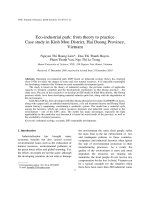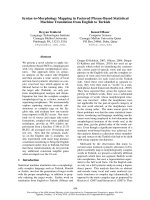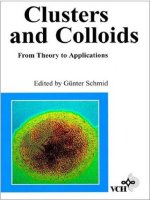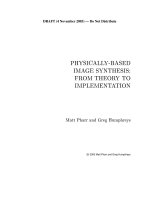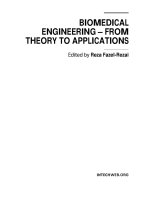Understand machine learning from theory to algorithms
Bạn đang xem bản rút gọn của tài liệu. Xem và tải ngay bản đầy đủ của tài liệu tại đây (2.48 MB, 449 trang )
Understanding Machine Learning:
From Theory to Algorithms
c 2014 by Shai Shalev-Shwartz and Shai Ben-David
Published 2014 by Cambridge University Press.
This copy is for personal use only. Not for distribution.
Do not post. Please link to:
/>
Please note: This copy is almost, but not entirely, identical to the printed version
of the book. In particular, page numbers are not identical (but section numbers are the
same).
Understanding Machine Learning
Machine learning is one of the fastest growing areas of computer science,
with far-reaching applications. The aim of this textbook is to introduce
machine learning, and the algorithmic paradigms it offers, in a principled way. The book provides an extensive theoretical account of the
fundamental ideas underlying machine learning and the mathematical
derivations that transform these principles into practical algorithms. Following a presentation of the basics of the field, the book covers a wide
array of central topics that have not been addressed by previous textbooks. These include a discussion of the computational complexity of
learning and the concepts of convexity and stability; important algorithmic paradigms including stochastic gradient descent, neural networks,
and structured output learning; and emerging theoretical concepts such as
the PAC-Bayes approach and compression-based bounds. Designed for
an advanced undergraduate or beginning graduate course, the text makes
the fundamentals and algorithms of machine learning accessible to students and nonexpert readers in statistics, computer science, mathematics,
and engineering.
Shai Shalev-Shwartz is an Associate Professor at the School of Computer
Science and Engineering at The Hebrew University, Israel.
Shai Ben-David is a Professor in the School of Computer Science at the
University of Waterloo, Canada.
UNDERSTANDING
MACHINE LEARNING
From Theory to
Algorithms
Shai Shalev-Shwartz
The Hebrew University, Jerusalem
Shai Ben-David
University of Waterloo, Canada
32 Avenue of the Americas, New York, NY 10013-2473, USA
Cambridge University Press is part of the University of Cambridge.
It furthers the University’s mission by disseminating knowledge in the pursuit of
education, learning and research at the highest international levels of excellence.
www.cambridge.org
Information on this title: www.cambridge.org/9781107057135
c Shai Shalev-Shwartz and Shai Ben-David 2014
⃝
This publication is in copyright. Subject to statutory exception
and to the provisions of relevant collective licensing agreements,
no reproduction of any part may take place without the written
permission of Cambridge University Press.
First published 2014
Printed in the United States of America
A catalog record for this publication is available from the British Library
Library of Congress Cataloging in Publication Data
ISBN 978-1-107-05713-5 Hardback
Cambridge University Press has no responsibility for the persistence or accuracy of
URLs for external or third-party Internet Web sites referred to in this publication,
and does not guarantee that any content on such Web sites is, or will remain,
accurate or appropriate.
Triple-S dedicates the book to triple-M
vii
Preface
The term machine learning refers to the automated detection of meaningful
patterns in data. In the past couple of decades it has become a common tool in
almost any task that requires information extraction from large data sets. We are
surrounded by a machine learning based technology: search engines learn how
to bring us the best results (while placing profitable ads), anti-spam software
learns to filter our email messages, and credit card transactions are secured by
a software that learns how to detect frauds. Digital cameras learn to detect
faces and intelligent personal assistance applications on smart-phones learn to
recognize voice commands. Cars are equipped with accident prevention systems
that are built using machine learning algorithms. Machine learning is also widely
used in scientific applications such as bioinformatics, medicine, and astronomy.
One common feature of all of these applications is that, in contrast to more
traditional uses of computers, in these cases, due to the complexity of the patterns
that need to be detected, a human programmer cannot provide an explicit, finedetailed specification of how such tasks should be executed. Taking example from
intelligent beings, many of our skills are acquired or refined through learning from
our experience (rather than following explicit instructions given to us). Machine
learning tools are concerned with endowing programs with the ability to “learn”
and adapt.
The first goal of this book is to provide a rigorous, yet easy to follow, introduction to the main concepts underlying machine learning: What is learning?
How can a machine learn? How do we quantify the resources needed to learn a
given concept? Is learning always possible? Can we know if the learning process
succeeded or failed?
The second goal of this book is to present several key machine learning algorithms. We chose to present algorithms that on one hand are successfully used
in practice and on the other hand give a wide spectrum of different learning
techniques. Additionally, we pay specific attention to algorithms appropriate for
large scale learning (a.k.a. “Big Data”), since in recent years, our world has become increasingly “digitized” and the amount of data available for learning is
dramatically increasing. As a result, in many applications data is plentiful and
computation time is the main bottleneck. We therefore explicitly quantify both
the amount of data and the amount of computation time needed to learn a given
concept.
The book is divided into four parts. The first part aims at giving an initial
rigorous answer to the fundamental questions of learning. We describe a generalization of Valiant’s Probably Approximately Correct (PAC) learning model,
which is a first solid answer to the question “what is learning?”. We describe
the Empirical Risk Minimization (ERM), Structural Risk Minimization (SRM),
and Minimum Description Length (MDL) learning rules, which shows “how can
a machine learn”. We quantify the amount of data needed for learning using
the ERM, SRM, and MDL rules and show how learning might fail by deriving
viii
a “no-free-lunch” theorem. We also discuss how much computation time is required for learning. In the second part of the book we describe various learning
algorithms. For some of the algorithms, we first present a more general learning
principle, and then show how the algorithm follows the principle. While the first
two parts of the book focus on the PAC model, the third part extends the scope
by presenting a wider variety of learning models. Finally, the last part of the
book is devoted to advanced theory.
We made an attempt to keep the book as self-contained as possible. However,
the reader is assumed to be comfortable with basic notions of probability, linear
algebra, analysis, and algorithms. The first three parts of the book are intended
for first year graduate students in computer science, engineering, mathematics, or
statistics. It can also be accessible to undergraduate students with the adequate
background. The more advanced chapters can be used by researchers intending
to gather a deeper theoretical understanding.
Acknowledgements
The book is based on Introduction to Machine Learning courses taught by Shai
Shalev-Shwartz at the Hebrew University and by Shai Ben-David at the University of Waterloo. The first draft of the book grew out of the lecture notes for
the course that was taught at the Hebrew University by Shai Shalev-Shwartz
during 2010–2013. We greatly appreciate the help of Ohad Shamir, who served
as a TA for the course in 2010, and of Alon Gonen, who served as a TA for the
course in 2011–2013. Ohad and Alon prepared few lecture notes and many of
the exercises. Alon, to whom we are indebted for his help throughout the entire
making of the book, has also prepared a solution manual.
We are deeply grateful for the most valuable work of Dana Rubinstein. Dana
has scientifically proofread and edited the manuscript, transforming it from
lecture-based chapters into fluent and coherent text.
Special thanks to Amit Daniely, who helped us with a careful read of the
advanced part of the book and also wrote the advanced chapter on multiclass
learnability. We are also grateful for the members of a book reading club in
Jerusalem that have carefully read and constructively criticized every line of
the manuscript. The members of the reading club are: Maya Alroy, Yossi Arjevani, Aharon Birnbaum, Alon Cohen, Alon Gonen, Roi Livni, Ofer Meshi, Dan
Rosenbaum, Dana Rubinstein, Shahar Somin, Alon Vinnikov, and Yoav Wald.
We would also like to thank Gal Elidan, Amir Globerson, Nika Haghtalab, Shie
Mannor, Amnon Shashua, Nati Srebro, and Ruth Urner for helpful discussions.
Shai Shalev-Shwartz, Jerusalem, Israel
Shai Ben-David, Waterloo, Canada
Contents
Preface
1
Part I
page vii
Introduction
1.1
What Is Learning?
1.2
When Do We Need Machine Learning?
1.3
Types of Learning
1.4
Relations to Other Fields
1.5
How to Read This Book
1.5.1 Possible Course Plans Based on This Book
1.6
Notation
Foundations
19
19
21
22
24
25
26
27
31
2
A Gentle Start
2.1
A Formal Model – The Statistical Learning Framework
2.2
Empirical Risk Minimization
2.2.1 Something May Go Wrong – Overfitting
2.3
Empirical Risk Minimization with Inductive Bias
2.3.1 Finite Hypothesis Classes
2.4
Exercises
33
33
35
35
36
37
41
3
A Formal Learning Model
3.1
PAC Learning
3.2
A More General Learning Model
3.2.1 Releasing the Realizability Assumption – Agnostic PAC
Learning
3.2.2 The Scope of Learning Problems Modeled
3.3
Summary
3.4
Bibliographic Remarks
3.5
Exercises
43
43
44
Learning via Uniform Convergence
4.1
Uniform Convergence Is Sufficient for Learnability
4.2
Finite Classes Are Agnostic PAC Learnable
54
54
55
4
Understanding Machine Learning, c 2014 by Shai Shalev-Shwartz and Shai Ben-David
Published 2014 by Cambridge University Press.
Personal use only. Not for distribution. Do not post.
Please link to />
45
47
49
50
50
x
Contents
4.3
4.4
4.5
Summary
Bibliographic Remarks
Exercises
58
58
58
5
The Bias-Complexity Tradeoff
5.1
The No-Free-Lunch Theorem
5.1.1 No-Free-Lunch and Prior Knowledge
5.2
Error Decomposition
5.3
Summary
5.4
Bibliographic Remarks
5.5
Exercises
60
61
63
64
65
66
66
6
The
6.1
6.2
6.3
67
67
68
70
70
71
71
72
72
72
73
73
75
78
78
78
6.4
6.5
6.6
6.7
6.8
VC-Dimension
Infinite-Size Classes Can Be Learnable
The VC-Dimension
Examples
6.3.1 Threshold Functions
6.3.2 Intervals
6.3.3 Axis Aligned Rectangles
6.3.4 Finite Classes
6.3.5 VC-Dimension and the Number of Parameters
The Fundamental Theorem of PAC learning
Proof of Theorem 6.7
6.5.1 Sauer’s Lemma and the Growth Function
6.5.2 Uniform Convergence for Classes of Small Effective Size
Summary
Bibliographic remarks
Exercises
7
Nonuniform Learnability
7.1
Nonuniform Learnability
7.1.1 Characterizing Nonuniform Learnability
7.2
Structural Risk Minimization
7.3
Minimum Description Length and Occam’s Razor
7.3.1 Occam’s Razor
7.4
Other Notions of Learnability – Consistency
7.5
Discussing the Different Notions of Learnability
7.5.1 The No-Free-Lunch Theorem Revisited
7.6
Summary
7.7
Bibliographic Remarks
7.8
Exercises
8
The Runtime of Learning
8.1
Computational Complexity of Learning
83
83
84
85
89
91
92
93
95
96
97
97
100
101
Contents
8.2
8.3
8.4
8.5
8.6
8.7
Part II
8.1.1 Formal Definition*
Implementing the ERM Rule
8.2.1 Finite Classes
8.2.2 Axis Aligned Rectangles
8.2.3 Boolean Conjunctions
8.2.4 Learning 3-Term DNF
Efficiently Learnable, but Not by a Proper ERM
Hardness of Learning*
Summary
Bibliographic Remarks
Exercises
From Theory to Algorithms
xi
102
103
104
105
106
107
107
108
110
110
110
115
9
Linear Predictors
9.1
Halfspaces
9.1.1 Linear Programming for the Class of Halfspaces
9.1.2 Perceptron for Halfspaces
9.1.3 The VC Dimension of Halfspaces
9.2
Linear Regression
9.2.1 Least Squares
9.2.2 Linear Regression for Polynomial Regression Tasks
9.3
Logistic Regression
9.4
Summary
9.5
Bibliographic Remarks
9.6
Exercises
117
118
119
120
122
123
124
125
126
128
128
128
10
Boosting
10.1 Weak Learnability
10.1.1 Efficient Implementation of ERM for Decision Stumps
10.2 AdaBoost
10.3 Linear Combinations of Base Hypotheses
10.3.1 The VC-Dimension of L(B, T )
10.4 AdaBoost for Face Recognition
10.5 Summary
10.6 Bibliographic Remarks
10.7 Exercises
130
131
133
134
137
139
140
141
141
142
11
Model Selection and Validation
11.1 Model Selection Using SRM
11.2 Validation
11.2.1 Hold Out Set
11.2.2 Validation for Model Selection
11.2.3 The Model-Selection Curve
144
145
146
146
147
148
xii
Contents
11.3
11.4
11.5
11.2.4 k-Fold Cross Validation
11.2.5 Train-Validation-Test Split
What to Do If Learning Fails
Summary
Exercises
149
150
151
154
154
12
Convex Learning Problems
12.1 Convexity, Lipschitzness, and Smoothness
12.1.1 Convexity
12.1.2 Lipschitzness
12.1.3 Smoothness
12.2 Convex Learning Problems
12.2.1 Learnability of Convex Learning Problems
12.2.2 Convex-Lipschitz/Smooth-Bounded Learning Problems
12.3 Surrogate Loss Functions
12.4 Summary
12.5 Bibliographic Remarks
12.6 Exercises
156
156
156
160
162
163
164
166
167
168
169
169
13
Regularization and Stability
13.1 Regularized Loss Minimization
13.1.1 Ridge Regression
13.2 Stable Rules Do Not Overfit
13.3 Tikhonov Regularization as a Stabilizer
13.3.1 Lipschitz Loss
13.3.2 Smooth and Nonnegative Loss
13.4 Controlling the Fitting-Stability Tradeoff
13.5 Summary
13.6 Bibliographic Remarks
13.7 Exercises
171
171
172
173
174
176
177
178
180
180
181
14
Stochastic Gradient Descent
14.1 Gradient Descent
14.1.1 Analysis of GD for Convex-Lipschitz Functions
14.2 Subgradients
14.2.1 Calculating Subgradients
14.2.2 Subgradients of Lipschitz Functions
14.2.3 Subgradient Descent
14.3 Stochastic Gradient Descent (SGD)
14.3.1 Analysis of SGD for Convex-Lipschitz-Bounded Functions
14.4 Variants
14.4.1 Adding a Projection Step
14.4.2 Variable Step Size
14.4.3 Other Averaging Techniques
184
185
186
188
189
190
190
191
191
193
193
194
195
Contents
14.5
14.6
14.7
14.8
14.4.4 Strongly Convex Functions*
Learning with SGD
14.5.1 SGD for Risk Minimization
14.5.2 Analyzing SGD for Convex-Smooth Learning Problems
14.5.3 SGD for Regularized Loss Minimization
Summary
Bibliographic Remarks
Exercises
xiii
195
196
196
198
199
200
200
201
15
Support Vector Machines
15.1 Margin and Hard-SVM
15.1.1 The Homogenous Case
15.1.2 The Sample Complexity of Hard-SVM
15.2 Soft-SVM and Norm Regularization
15.2.1 The Sample Complexity of Soft-SVM
15.2.2 Margin and Norm-Based Bounds versus Dimension
15.2.3 The Ramp Loss*
15.3 Optimality Conditions and “Support Vectors”*
15.4 Duality*
15.5 Implementing Soft-SVM Using SGD
15.6 Summary
15.7 Bibliographic Remarks
15.8 Exercises
202
202
205
205
206
208
208
209
210
211
212
213
213
214
16
Kernel Methods
16.1 Embeddings into Feature Spaces
16.2 The Kernel Trick
16.2.1 Kernels as a Way to Express Prior Knowledge
16.2.2 Characterizing Kernel Functions*
16.3 Implementing Soft-SVM with Kernels
16.4 Summary
16.5 Bibliographic Remarks
16.6 Exercises
215
215
217
221
222
222
224
225
225
17
Multiclass, Ranking, and Complex Prediction Problems
17.1 One-versus-All and All-Pairs
17.2 Linear Multiclass Predictors
17.2.1 How to Construct Ψ
17.2.2 Cost-Sensitive Classification
17.2.3 ERM
17.2.4 Generalized Hinge Loss
17.2.5 Multiclass SVM and SGD
17.3 Structured Output Prediction
17.4 Ranking
227
227
230
230
232
232
233
234
236
238
xiv
Contents
17.4.1 Linear Predictors for Ranking
Bipartite Ranking and Multivariate Performance Measures
17.5.1 Linear Predictors for Bipartite Ranking
Summary
Bibliographic Remarks
Exercises
240
243
245
247
247
248
18
Decision Trees
18.1 Sample Complexity
18.2 Decision Tree Algorithms
18.2.1 Implementations of the Gain Measure
18.2.2 Pruning
18.2.3 Threshold-Based Splitting Rules for Real-Valued Features
18.3 Random Forests
18.4 Summary
18.5 Bibliographic Remarks
18.6 Exercises
250
251
252
253
254
255
255
256
256
256
19
Nearest Neighbor
19.1 k Nearest Neighbors
19.2 Analysis
19.2.1 A Generalization Bound for the 1-NN Rule
19.2.2 The “Curse of Dimensionality”
19.3 Efficient Implementation*
19.4 Summary
19.5 Bibliographic Remarks
19.6 Exercises
258
258
259
260
263
264
264
264
265
20
Neural Networks
20.1 Feedforward Neural Networks
20.2 Learning Neural Networks
20.3 The Expressive Power of Neural Networks
20.3.1 Geometric Intuition
20.4 The Sample Complexity of Neural Networks
20.5 The Runtime of Learning Neural Networks
20.6 SGD and Backpropagation
20.7 Summary
20.8 Bibliographic Remarks
20.9 Exercises
268
269
270
271
273
274
276
277
281
281
282
Part III
Additional Learning Models
285
21
Online Learning
21.1 Online Classification in the Realizable Case
287
288
17.5
17.6
17.7
17.8
Contents
xv
21.1.1 Online Learnability
Online Classification in the Unrealizable Case
21.2.1 Weighted-Majority
Online Convex Optimization
The Online Perceptron Algorithm
Summary
Bibliographic Remarks
Exercises
290
294
295
300
301
304
305
305
22
Clustering
22.1 Linkage-Based Clustering Algorithms
22.2 k-Means and Other Cost Minimization Clusterings
22.2.1 The k-Means Algorithm
22.3 Spectral Clustering
22.3.1 Graph Cut
22.3.2 Graph Laplacian and Relaxed Graph Cuts
22.3.3 Unnormalized Spectral Clustering
22.4 Information Bottleneck*
22.5 A High Level View of Clustering
22.6 Summary
22.7 Bibliographic Remarks
22.8 Exercises
307
310
311
313
315
315
315
317
317
318
320
320
320
23
Dimensionality Reduction
23.1 Principal Component Analysis (PCA)
23.1.1 A More Efficient Solution for the Case d
23.1.2 Implementation and Demonstration
23.2 Random Projections
23.3 Compressed Sensing
23.3.1 Proofs*
23.4 PCA or Compressed Sensing?
23.5 Summary
23.6 Bibliographic Remarks
23.7 Exercises
323
324
326
326
329
330
333
338
338
339
339
21.2
21.3
21.4
21.5
21.6
21.7
24
m
Generative Models
24.1 Maximum Likelihood Estimator
24.1.1 Maximum Likelihood Estimation for Continuous Random Variables
24.1.2 Maximum Likelihood and Empirical Risk Minimization
24.1.3 Generalization Analysis
24.2 Naive Bayes
24.3 Linear Discriminant Analysis
24.4 Latent Variables and the EM Algorithm
342
343
344
345
345
347
347
348
xvi
Contents
24.5
24.6
24.7
24.8
24.4.1 EM as an Alternate Maximization Algorithm
24.4.2 EM for Mixture of Gaussians (Soft k-Means)
Bayesian Reasoning
Summary
Bibliographic Remarks
Exercises
350
352
353
355
355
356
25
Feature Selection and Generation
25.1 Feature Selection
25.1.1 Filters
25.1.2 Greedy Selection Approaches
25.1.3 Sparsity-Inducing Norms
25.2 Feature Manipulation and Normalization
25.2.1 Examples of Feature Transformations
25.3 Feature Learning
25.3.1 Dictionary Learning Using Auto-Encoders
25.4 Summary
25.5 Bibliographic Remarks
25.6 Exercises
357
358
359
360
363
365
367
368
368
370
371
371
Part IV
Advanced Theory
373
26
Rademacher Complexities
26.1 The Rademacher Complexity
26.1.1 Rademacher Calculus
26.2 Rademacher Complexity of Linear Classes
26.3 Generalization Bounds for SVM
26.4 Generalization Bounds for Predictors with Low
26.5 Bibliographic Remarks
375
375
379
382
383
386
386
1
Norm
27
Covering Numbers
27.1 Covering
27.1.1 Properties
27.2 From Covering to Rademacher Complexity via Chaining
27.3 Bibliographic Remarks
388
388
388
389
391
28
Proof of the Fundamental Theorem of Learning Theory
28.1 The Upper Bound for the Agnostic Case
28.2 The Lower Bound for the Agnostic Case
28.2.1 Showing That m( , δ) ≥ 0.5 log(1/(4δ))/
28.2.2 Showing That m( , 1/8) ≥ 8d/ 2
28.3 The Upper Bound for the Realizable Case
28.3.1 From -Nets to PAC Learnability
392
392
393
393
395
398
401
2
Contents
xvii
29
Multiclass Learnability
29.1 The Natarajan Dimension
29.2 The Multiclass Fundamental Theorem
29.2.1 On the Proof of Theorem 29.3
29.3 Calculating the Natarajan Dimension
29.3.1 One-versus-All Based Classes
29.3.2 General Multiclass-to-Binary Reductions
29.3.3 Linear Multiclass Predictors
29.4 On Good and Bad ERMs
29.5 Bibliographic Remarks
29.6 Exercises
402
402
403
403
404
404
405
405
406
408
409
30
Compression Bounds
30.1 Compression Bounds
30.2 Examples
30.2.1 Axis Aligned Rectangles
30.2.2 Halfspaces
30.2.3 Separating Polynomials
30.2.4 Separation with Margin
30.3 Bibliographic Remarks
410
410
412
412
412
413
414
414
31
PAC-Bayes
31.1 PAC-Bayes Bounds
31.2 Bibliographic Remarks
31.3 Exercises
415
415
417
417
Appendix A
Technical Lemmas
419
Appendix B
Measure Concentration
422
Appendix C
Linear Algebra
430
Notes
References
Index
435
437
447
1
Introduction
The subject of this book is automated learning, or, as we will more often call
it, Machine Learning (ML). That is, we wish to program computers so that
they can “learn” from input available to them. Roughly speaking, learning is
the process of converting experience into expertise or knowledge. The input to
a learning algorithm is training data, representing experience, and the output
is some expertise, which usually takes the form of another computer program
that can perform some task. Seeking a formal-mathematical understanding of
this concept, we’ll have to be more explicit about what we mean by each of the
involved terms: What is the training data our programs will access? How can
the process of learning be automated? How can we evaluate the success of such
a process (namely, the quality of the output of a learning program)?
1.1
What Is Learning?
Let us begin by considering a couple of examples from naturally occurring animal learning. Some of the most fundamental issues in ML arise already in that
context, which we are all familiar with.
Bait Shyness – Rats Learning to Avoid Poisonous Baits: When rats encounter
food items with novel look or smell, they will first eat very small amounts, and
subsequent feeding will depend on the flavor of the food and its physiological
effect. If the food produces an ill effect, the novel food will often be associated
with the illness, and subsequently, the rats will not eat it. Clearly, there is a
learning mechanism in play here – the animal used past experience with some
food to acquire expertise in detecting the safety of this food. If past experience
with the food was negatively labeled, the animal predicts that it will also have
a negative effect when encountered in the future.
Inspired by the preceding example of successful learning, let us demonstrate a
typical machine learning task. Suppose we would like to program a machine that
learns how to filter spam e-mails. A naive solution would be seemingly similar
to the way rats learn how to avoid poisonous baits. The machine will simply
memorize all previous e-mails that had been labeled as spam e-mails by the
human user. When a new e-mail arrives, the machine will search for it in the set
Understanding Machine Learning, c 2014 by Shai Shalev-Shwartz and Shai Ben-David
Published 2014 by Cambridge University Press.
Personal use only. Not for distribution. Do not post.
Please link to />
20
Introduction
of previous spam e-mails. If it matches one of them, it will be trashed. Otherwise,
it will be moved to the user’s inbox folder.
While the preceding “learning by memorization” approach is sometimes useful, it lacks an important aspect of learning systems – the ability to label unseen
e-mail messages. A successful learner should be able to progress from individual
examples to broader generalization. This is also referred to as inductive reasoning
or inductive inference. In the bait shyness example presented previously, after
the rats encounter an example of a certain type of food, they apply their attitude
toward it on new, unseen examples of food of similar smell and taste. To achieve
generalization in the spam filtering task, the learner can scan the previously seen
e-mails, and extract a set of words whose appearance in an e-mail message is
indicative of spam. Then, when a new e-mail arrives, the machine can check
whether one of the suspicious words appears in it, and predict its label accordingly. Such a system would potentially be able correctly to predict the label of
unseen e-mails.
However, inductive reasoning might lead us to false conclusions. To illustrate
this, let us consider again an example from animal learning.
Pigeon Superstition: In an experiment performed by the psychologist B. F. Skinner,
he placed a bunch of hungry pigeons in a cage. An automatic mechanism had
been attached to the cage, delivering food to the pigeons at regular intervals
with no reference whatsoever to the birds’ behavior. The hungry pigeons went
around the cage, and when food was first delivered, it found each pigeon engaged
in some activity (pecking, turning the head, etc.). The arrival of food reinforced
each bird’s specific action, and consequently, each bird tended to spend some
more time doing that very same action. That, in turn, increased the chance that
the next random food delivery would find each bird engaged in that activity
again. What results is a chain of events that reinforces the pigeons’ association
of the delivery of the food with whatever chance actions they had been performing when it was first delivered. They subsequently continue to perform these
same actions diligently.1
What distinguishes learning mechanisms that result in superstition from useful
learning? This question is crucial to the development of automated learners.
While human learners can rely on common sense to filter out random meaningless
learning conclusions, once we export the task of learning to a machine, we must
provide well defined crisp principles that will protect the program from reaching
senseless or useless conclusions. The development of such principles is a central
goal of the theory of machine learning.
What, then, made the rats’ learning more successful than that of the pigeons?
As a first step toward answering this question, let us have a closer look at the
bait shyness phenomenon in rats.
Bait Shyness revisited – rats fail to acquire conditioning between food and
electric shock or between sound and nausea: The bait shyness mechanism in
1
See: />
1.2 When Do We Need Machine Learning?
21
rats turns out to be more complex than what one may expect. In experiments
carried out by Garcia (Garcia & Koelling 1996), it was demonstrated that if the
unpleasant stimulus that follows food consumption is replaced by, say, electrical
shock (rather than nausea), then no conditioning occurs. Even after repeated
trials in which the consumption of some food is followed by the administration of
unpleasant electrical shock, the rats do not tend to avoid that food. Similar failure
of conditioning occurs when the characteristic of the food that implies nausea
(such as taste or smell) is replaced by a vocal signal. The rats seem to have
some “built in” prior knowledge telling them that, while temporal correlation
between food and nausea can be causal, it is unlikely that there would be a
causal relationship between food consumption and electrical shocks or between
sounds and nausea.
We conclude that one distinguishing feature between the bait shyness learning
and the pigeon superstition is the incorporation of prior knowledge that biases
the learning mechanism. This is also referred to as inductive bias. The pigeons in
the experiment are willing to adopt any explanation for the occurrence of food.
However, the rats “know” that food cannot cause an electric shock and that the
co-occurrence of noise with some food is not likely to affect the nutritional value
of that food. The rats’ learning process is biased toward detecting some kind of
patterns while ignoring other temporal correlations between events.
It turns out that the incorporation of prior knowledge, biasing the learning
process, is inevitable for the success of learning algorithms (this is formally stated
and proved as the “No-Free-Lunch theorem” in Chapter 5). The development of
tools for expressing domain expertise, translating it into a learning bias, and
quantifying the effect of such a bias on the success of learning is a central theme
of the theory of machine learning. Roughly speaking, the stronger the prior
knowledge (or prior assumptions) that one starts the learning process with, the
easier it is to learn from further examples. However, the stronger these prior
assumptions are, the less flexible the learning is – it is bound, a priori, by the
commitment to these assumptions. We shall discuss these issues explicitly in
Chapter 5.
1.2
When Do We Need Machine Learning?
When do we need machine learning rather than directly program our computers
to carry out the task at hand? Two aspects of a given problem may call for the
use of programs that learn and improve on the basis of their “experience”: the
problem’s complexity and the need for adaptivity.
Tasks That Are Too Complex to Program.
• Tasks Performed by Animals/Humans: There are numerous tasks that
we human beings perform routinely, yet our introspection concerning how we do them is not sufficiently elaborate to extract a well
22
Introduction
defined program. Examples of such tasks include driving, speech
recognition, and image understanding. In all of these tasks, state
of the art machine learning programs, programs that “learn from
their experience,” achieve quite satisfactory results, once exposed
to sufficiently many training examples.
• Tasks beyond Human Capabilities: Another wide family of tasks that
benefit from machine learning techniques are related to the analysis of very large and complex data sets: astronomical data, turning
medical archives into medical knowledge, weather prediction, analysis of genomic data, Web search engines, and electronic commerce.
With more and more available digitally recorded data, it becomes
obvious that there are treasures of meaningful information buried
in data archives that are way too large and too complex for humans
to make sense of. Learning to detect meaningful patterns in large
and complex data sets is a promising domain in which the combination of programs that learn with the almost unlimited memory
capacity and ever increasing processing speed of computers opens
up new horizons.
Adaptivity. One limiting feature of programmed tools is their rigidity – once
the program has been written down and installed, it stays unchanged.
However, many tasks change over time or from one user to another.
Machine learning tools – programs whose behavior adapts to their input
data – offer a solution to such issues; they are, by nature, adaptive
to changes in the environment they interact with. Typical successful
applications of machine learning to such problems include programs that
decode handwritten text, where a fixed program can adapt to variations
between the handwriting of different users; spam detection programs,
adapting automatically to changes in the nature of spam e-mails; and
speech recognition programs.
1.3
Types of Learning
Learning is, of course, a very wide domain. Consequently, the field of machine
learning has branched into several subfields dealing with different types of learning tasks. We give a rough taxonomy of learning paradigms, aiming to provide
some perspective of where the content of this book sits within the wide field of
machine learning.
We describe four parameters along which learning paradigms can be classified.
Supervised versus Unsupervised Since learning involves an interaction between the learner and the environment, one can divide learning tasks
according to the nature of that interaction. The first distinction to note
is the difference between supervised and unsupervised learning. As an
1.3 Types of Learning
23
illustrative example, consider the task of learning to detect spam e-mail
versus the task of anomaly detection. For the spam detection task, we
consider a setting in which the learner receives training e-mails for which
the label spam/not-spam is provided. On the basis of such training the
learner should figure out a rule for labeling a newly arriving e-mail message. In contrast, for the task of anomaly detection, all the learner gets
as training is a large body of e-mail messages (with no labels) and the
learner’s task is to detect “unusual” messages.
More abstractly, viewing learning as a process of “using experience
to gain expertise,” supervised learning describes a scenario in which the
“experience,” a training example, contains significant information (say,
the spam/not-spam labels) that is missing in the unseen “test examples”
to which the learned expertise is to be applied. In this setting, the acquired expertise is aimed to predict that missing information for the test
data. In such cases, we can think of the environment as a teacher that
“supervises” the learner by providing the extra information (labels). In
unsupervised learning, however, there is no distinction between training
and test data. The learner processes input data with the goal of coming
up with some summary, or compressed version of that data. Clustering
a data set into subsets of similar objets is a typical example of such a
task.
There is also an intermediate learning setting in which, while the
training examples contain more information than the test examples, the
learner is required to predict even more information for the test examples. For example, one may try to learn a value function that describes for
each setting of a chess board the degree by which White’s position is better than the Black’s. Yet, the only information available to the learner at
training time is positions that occurred throughout actual chess games,
labeled by who eventually won that game. Such learning frameworks are
mainly investigated under the title of reinforcement learning.
Active versus Passive Learners Learning paradigms can vary by the role
played by the learner. We distinguish between “active” and “passive”
learners. An active learner interacts with the environment at training
time, say, by posing queries or performing experiments, while a passive
learner only observes the information provided by the environment (or
the teacher) without influencing or directing it. Note that the learner of a
spam filter is usually passive – waiting for users to mark the e-mails coming to them. In an active setting, one could imagine asking users to label
specific e-mails chosen by the learner, or even composed by the learner, to
enhance
its
understanding
of
what
spam is.
Helpfulness of the Teacher When one thinks about human learning, of a
baby at home or a student at school, the process often involves a helpful
teacher, who is trying to feed the learner with the information most use-
24
Introduction
ful for achieving the learning goal. In contrast, when a scientist learns
about nature, the environment, playing the role of the teacher, can be
best thought of as passive – apples drop, stars shine, and the rain falls
without regard to the needs of the learner. We model such learning scenarios by postulating that the training data (or the learner’s experience)
is generated by some random process. This is the basic building block in
the branch of “statistical learning.” Finally, learning also occurs when
the learner’s input is generated by an adversarial “teacher.” This may be
the case in the spam filtering example (if the spammer makes an effort
to mislead the spam filtering designer) or in learning to detect fraud.
One also uses an adversarial teacher model as a worst-case scenario,
when no milder setup can be safely assumed. If you can learn against an
adversarial teacher, you are guaranteed to succeed interacting any odd
teacher.
Online versus Batch Learning Protocol The last parameter we mention is
the distinction between situations in which the learner has to respond
online, throughout the learning process, and settings in which the learner
has to engage the acquired expertise only after having a chance to process
large amounts of data. For example, a stockbroker has to make daily
decisions, based on the experience collected so far. He may become an
expert over time, but might have made costly mistakes in the process. In
contrast, in many data mining settings, the learner – the data miner –
has large amounts of training data to play with before having to output
conclusions.
In this book we shall discuss only a subset of the possible learning paradigms.
Our main focus is on supervised statistical batch learning with a passive learner
(for example, trying to learn how to generate patients’ prognoses, based on large
archives of records of patients that were independently collected and are already
labeled by the fate of the recorded patients). We shall also briefly discuss online
learning and batch unsupervised learning (in particular, clustering).
1.4
Relations to Other Fields
As an interdisciplinary field, machine learning shares common threads with the
mathematical fields of statistics, information theory, game theory, and optimization. It is naturally a subfield of computer science, as our goal is to program
machines so that they will learn. In a sense, machine learning can be viewed as
a branch of AI (Artificial Intelligence), since, after all, the ability to turn experience into expertise or to detect meaningful patterns in complex sensory data
is a cornerstone of human (and animal) intelligence. However, one should note
that, in contrast with traditional AI, machine learning is not trying to build
automated imitation of intelligent behavior, but rather to use the strengths and
1.5 How to Read This Book
25
special abilities of computers to complement human intelligence, often performing tasks that fall way beyond human capabilities. For example, the ability to
scan and process huge databases allows machine learning programs to detect
patterns that are outside the scope of human perception.
The component of experience, or training, in machine learning often refers
to data that is randomly generated. The task of the learner is to process such
randomly generated examples toward drawing conclusions that hold for the environment from which these examples are picked. This description of machine
learning highlights its close relationship with statistics. Indeed there is a lot in
common between the two disciplines, in terms of both the goals and techniques
used. There are, however, a few significant differences of emphasis; if a doctor
comes up with the hypothesis that there is a correlation between smoking and
heart disease, it is the statistician’s role to view samples of patients and check
the validity of that hypothesis (this is the common statistical task of hypothesis testing). In contrast, machine learning aims to use the data gathered from
samples of patients to come up with a description of the causes of heart disease.
The hope is that automated techniques may be able to figure out meaningful
patterns (or hypotheses) that may have been missed by the human observer.
In contrast with traditional statistics, in machine learning in general, and
in this book in particular, algorithmic considerations play a major role. Machine learning is about the execution of learning by computers; hence algorithmic issues are pivotal. We develop algorithms to perform the learning tasks and
are concerned with their computational efficiency. Another difference is that
while statistics is often interested in asymptotic behavior (like the convergence
of sample-based statistical estimates as the sample sizes grow to infinity), the
theory of machine learning focuses on finite sample bounds. Namely, given the
size of available samples, machine learning theory aims to figure out the degree
of accuracy that a learner can expect on the basis of such samples.
There are further differences between these two disciplines, of which we shall
mention only one more here. While in statistics it is common to work under the
assumption of certain presubscribed data models (such as assuming the normality of data-generating distributions, or the linearity of functional dependencies),
in machine learning the emphasis is on working under a “distribution-free” setting, where the learner assumes as little as possible about the nature of the
data distribution and allows the learning algorithm to figure out which models
best approximate the data-generating process. A precise discussion of this issue
requires some technical preliminaries, and we will come back to it later in the
book, and in particular in Chapter 5.
1.5
How to Read This Book
The first part of the book provides the basic theoretical principles that underlie
machine learning (ML). In a sense, this is the foundation upon which the rest
